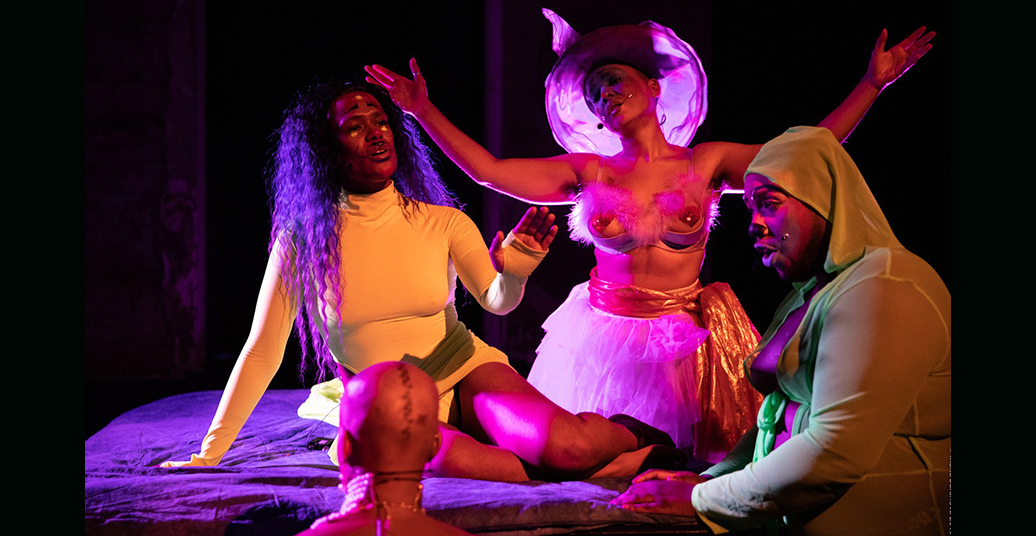Covid is stirring hard again. Due to corona precautions, the performance “Black Power Naps / Choir of the Slain (Part XX)” by artists and activists Fannie Sosa and Navild Acosta at the Sophiensæle needed to be cancelled. As an alternative, a live-stream was made available.
So I find myself behind a computer screen again. It’s an interesting situation to be in, given the theme of the Sophiensæle’s performance festival Risk and Resilience. The festival invites us to reflect on artistic, psychological, and political resistance, and, at the same time, questions the amount of resilience that is expected of individuals that are already disadvantaged in our society in terms of making their labour available. How can we avoid allowing flexibility to become instrumental to the neo-liberal market logics of producing, regardless of the amount of human capital it takes? How can we protect ourselves from becoming exhausted by the constant struggle, or from eroding ourselves? How much risk is there in resilience?
In “Black Power Naps / Choir of the Slain (Part XX)”, Fannie Sosa and Navild Acosta not only lay bare this exhaustion, but also offer BIPOC[1] a place to rest, to be still, to relax. Rest, relaxation and sleep are not distributed equally — BIPOC are statistically likely to sleep less than white people[2]. This is known as the Sleep Gap. Among other factors, stress arising from experiences of discrimination and the feeling of reduced agency lead to poor sleep, in terms of both quantity and quality. Sleep is directly linked to health. So in ‘western’ society, rest and relaxation is reserved for the privileged, as stated in the programme notes. Sleeping is therefore political.
The work was originally planned as a performance installation to sit and lie down in, but we’re now slowly drawn into the screen with dreamy, bombastic sounds and dots of green light. But this invitation is brutally interrupted by a voice demanding a restart. The experience of being abruptly thrown out of a certain atmosphere happens frequently during the performance, as a metaphor for a disrupted sleep, perhaps.
The top and side cameras show us three performers with painted faces, colourful clothing, and belly and breasts — nipples covered with glittery stars — exposed. Meet Captain Infinity Vanta Black from spaceship Black Power Naps and colleagues Droid Hydra DeGenderes and Droid Semiramis Starseed. They have arrived on an ashy, dry Earth with “low levels of empathy detected.” Their aim is to moisturise it with Black Joy, Black Pleasure, and Black Sleep — these are the titles of the chapters that introduce each section of the performance. Following the titles, informative texts expanding on each of the topics flow across the screen against a background of a moonlit sea. Due to the Gothic font, however, they are sometimes hard to read. After these introductions, the camera returns to the stage where an eclectic series of scenes take place. The captain declares an ode to a pair of heavy black boots, warning that on Judgement Day they are “gonna walk all over you.” Droid Semiramis Starseed raps about Otherness, being the Monster, the Unknown, the Outsider. Seated on a mattress with big cushions behind them, Droid Hydra DeGenderes sings Antony and the Johnsons’ Hope There’s Someone, in which the fear of sleep and death is put into words.
This all takes place on soft surfaces, with cushions and veils creating a luscious backdrop. A colourful lighting design and atmospheric sounds accentuate this as a place of comfort. The performers wear wigs, change clothes constantly, and sing, speak, caress and perform with a presence and sincerity that burst out of the screen. “Back Power Naps / Choir of the Slain (Part XX)” is the second part of a larger project, which will be an ‘eponymous evening-length opera’. I’m looking forward to being there in person and laying down on the bed that Navild Acosta and Fannie Sosa created.
You can still watch the performance online at: https://sophiensaele.com/en/archiv/stueck/navild-acosta-fannie-sosa-choir-of-the-slain-part-xx
[1] Black / indigenous / people of colour
[2] More information on the Sleep Gap can, for example be found here: https://www.theatlantic.com/health/archive/2015/10/the-sleep-gap-and-racial-inequality/412405/




